Getting Started¶
Installation¶
Install the wristpy package from PyPI via:
pip install wristpy
Introduction¶
The main processing pipeline of the wristpy module can be described as follows:
Data loading: sensor data is loaded using
actfast, and aWatchDataobject is created to store all sensor data.Data calibration: A post-manufacturer calibration step can be applied, to ensure that the acceleration sensor is measuring 1g force during periods of no motion. There are three possible options:
None,gradient,ggir.Data imputation In the special case when dealing with the Actigraph
idle_sleep_mode == enabled, the gaps in acceleration are filled in after calibration, to avoid biasing the calibration phase.Metrics Calculation: Calculates various activity metrics on the calibrated data, namely ENMO (Euclidean norm, minus one), MAD (mean amplitude deviation)1, Actigraph activity counts2, MIMS (monitor-independent movement summary) unit3, and angle-Z (angle of acceleration relative to the x-y axis).
Non-wear detection: We find periods of non-wear based on the acceleration data. Specifically, the standard deviation of the acceleration values in a given time window, along each axis, is used as a threshold to decide
wearornot wear. Additionally, we can use the temperature sensor, when available, to augment the acceleration data. This is used in the CTA (combined temperature and acceleration) algorithm4, and in theskdhDETACH algorithm5. Furthermore, ensemble classification of non-wear periods is possible by providing a list (of any length) of non-wear algorithm options.Sleep Detection: Using the HDCZ6 and HSPT7 algorithms to analyze changes in arm angle we are able to find periods of sleep. We find the sleep onset–wakeup times for all sleep windows detected. Any sleep periods that overlap with detected non-wear times are removed, and any remaining sleep periods shorter than 15 minutes (default value) are removed. Additionally, the SIB (sustained inactivity bouts) and the SPT (sleep period time) windows are provided as part of the output to aid in sleep metric post-processing.
Physical activity levels: Using the chosen physical activity metric (aggregated into time bins, 5-second default) we compute activity levels into the following categories: [
inactive,light,moderate,vigorous]. The threshold values can be defined by the user, while the default values are chosen based on the specific activity metric and the values found in the literature 8910.Data output: The output results can be saved in
.csvor.parquetdata formats, with the run-time configuration parameters saved in a.jsondictionary.
Supported formats & devices¶
The package currently supports the following formats:
Format |
Manufacturer |
Device |
Implementation status |
|---|---|---|---|
GT3X |
Actigraph |
wGT3X-BT |
✅ |
BIN |
GENEActiv |
GENEActiv |
✅ |
Command Line Tutorial¶
Run a single file:
wristpy /input/file/path.gt3x -o /save/path/file_name.csv -c gradient
Run an entire directory:
wristpy /path/to/files/input_dir -o /path/to/files/output_dir -c gradient -O .csv
You can also choose one or more activity metric:
wristpy /input/file/path.gt3x -o /save/path/file_name.csv -c gradient -a enmo -a mad
Specify the epoch length in seconds (will default to 5 seconds):
wristpy /input/file/path.gt3x -o /save/path/file_name.csv -c gradient -a enmo -a mad -e 3
To specificy your own activity thresholds enter them in the same order as the corresponding metric:
wristpy /input/file/path.gt3x -o /save/path/file_name.csv -c gradient -a enmo -a mad -t "1 2 3" -t "1.5 2.5 3.5"
See all available command-line arguments:
wristpy --help
Python Tutorial¶
Wristpy is a Python library designed for processing and analyzing wrist-worn accelerometer data.
This tutorial will guide you through the basic steps of using wristpy to analyze your accelerometer data using python. Specifically,
we will cover the following topics through a few examples:
running the default processor, analyzing the output data, and visualizing the results.
loading data and plotting the raw signals.
how to calibrate the data, computing ENMO and angle-z from the calibrated data and then plotting those metrics.
how to obtain non-wear windows and visualize them.
how to obtain sleep windows and visualize them.
Example 1: Running the default processor¶
Running files and directories¶
The orchestrator module of wristpy contains the default processor that will run the entire wristpy processing pipeline. This can be called as simply as:
import pathlib
from wristpy.core import orchestrator
input_directory = pathlib.Path('tutorial_data')
output_directory = pathlib.Path.cwd().parent / 'build'
results = orchestrator.run(
input = input_directory / 'three_nights.bin',
output = output_directory / 'three_nights_single_file.csv',
)
This runs the processing pipeline with all the default arguments, creates an output .csv file, a .json file with the pipeline configuration parameters, and will create a results object that contains the various output metrics (namely; the specified physical activity metric, angle-z, physical activity classification values, non-wear status, and sleep status).
The orchestrator can also process entire directories. The call to the orchestrator remains largely the same but now output is expected to be a directory and the desired filetype for the saved files can be specified through the output_filetype arguement(default value is “.csv”):
from wristpy.core import orchestrator
results = orchestrator.run(
input = input_directory,
output = output_directory,
output_filetype = ".csv"
)
If users would prefer to process specific files instead of entire directories we recommend looping through a list of file names. The following code snipet will save results objects into a dictionary, and the output files into the desired directory:
file_names = [pathlib.Path("three_nights.bin")] # Add more file names to list as needed
results_dict = {}
for file in file_names:
input_path = input_directory / file
output_path = output_directory / file.with_suffix('.csv')
result = orchestrator.run(
input = input_path,
output = output_path)
results_dict[file.stem] = result
Physical Activity Metrics & Results¶
Wristpy is capable of calculating the following physical activity metrics from actigraphy data:
The default metric is ENMO, but you can pass any combination of supported metrics as a list to the orchestrator:
results = orchestrator.run(
input = input_directory / 'three_nights.bin',
output = output_directory / 'three_nights_multiple_metrics.csv',
activity_metric = ['enmo', 'mad',]
)
The resulting OrchestratorResults object will contain the outputs for each metric in the order they were provided. The same applies to the physical activity levels associated with each metric.
enmo = results.physical_activity_metric[0]
mad = results.physical_activity_metric[1]
enmo_levels = results.physical_activity_levels[0]
mad_levels = results.physical_activity_levels[1]
We can visualize some of the outputs within the results object, directly, with the following scripts:
#Plot the default physical activity metrics (ENMO) across the entire data set:
from matplotlib import pyplot as plt
plt.plot(results.physical_activity_metric[0].time, results.physical_activity_metric[0].measurements)
---------------------------------------------------------------------------
ModuleNotFoundError Traceback (most recent call last)
Cell In[6], line 3
1 #Plot the default physical activity metrics (ENMO) across the entire data set:
----> 3 from matplotlib import pyplot as plt
5 plt.plot(results.physical_activity_metric[0].time, results.physical_activity_metric[0].measurements)
ModuleNotFoundError: No module named 'matplotlib'
# Plot the sleep windows with normalized angle-z data:
from matplotlib import pyplot as plt
plt.plot(results.anglez.time, results.anglez.measurements/90)
plt.plot(results.sleep_status.time, results.sleep_status.measurements)
plt.legend(['Angle Z', 'Sleep Windows'])
plt.show()
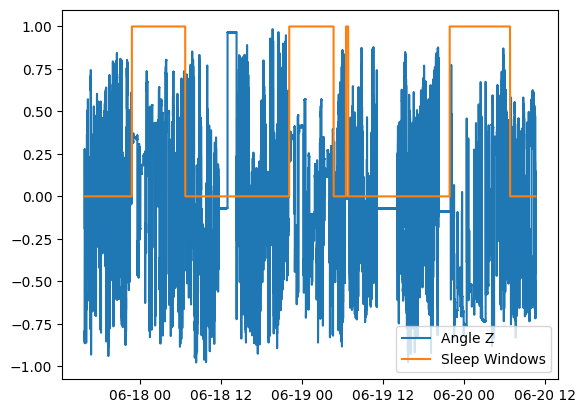
#We can also view and process these outputs from the saved `.csv` output file:
import matplotlib.pyplot as plt
import polars as pl
output_results = pl.read_csv(output_directory/ 'three_nights.csv', try_parse_dates=True)
activity_mapping = {
"inactive": 0,
"light": 1,
"moderate": 2,
"vigorous": 3
}
phys_activity = output_results['enmo physical activity levels'].replace(activity_mapping).cast(int)
plt.plot(output_results['time'], phys_activity)
[<matplotlib.lines.Line2D at 0x2af754850>]
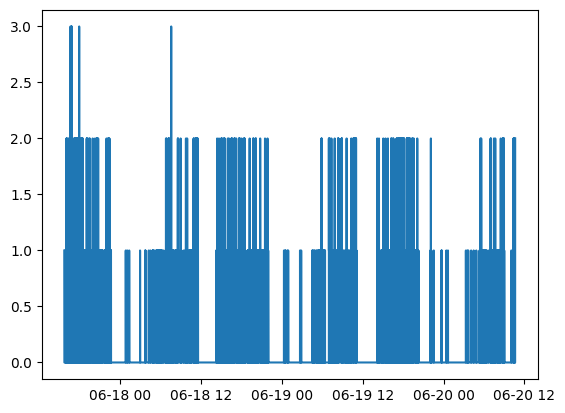
# It is also possible to do some analysis on these output variables, for example, if we want to find the percent of time spent inactive, or in light, moderate, or vigorous physical activity:
inactivity_count = sum(phys_activity == 0)
light_activity_count = sum(phys_activity == 1)
moderate_activity_count = sum(phys_activity == 2)
vigorous_activity_count = sum(phys_activity == 3)
total_activity_count = len(output_results['enmo physical activity levels'])
print(f'Light activity percent: {light_activity_count*100/total_activity_count}')
print(f'Moderate activity percent: {moderate_activity_count*100/total_activity_count}')
print(f'Vigorous activity percent: {vigorous_activity_count*100/total_activity_count}')
print(f'Inactivity percent: {inactivity_count*100/total_activity_count}')
Light activity percent: 12.394840157038699
Moderate activity percent: 1.1030099083940923
Vigorous activity percent: 0.031158471988533682
Inactivity percent: 86.47099146257868
Configuring a custom pipeline
A custom processing pipeline can be easily created by modifying the input arguments to the
orchestrator.runcall.Complete documentation on these parameters can be found here. Example:
results = orchestrator.run(input = input_directory / "three_nights.bin", output = output_directory / "custom_pipeline.csv", output_filetype = ".parquet", calibrator="gradient", activity_metric=["ag_count"], nonwear_algorithm=["detach"], epoch_length=10, thresholds=[(0.05, 0.1, 0.3)])
Example 2: Loading data and plotting the raw signals¶
In this example we will go over the built-in functions to directly read the raw accelerometer and light data, and how to quickly visualize this information.
The built-in readers module can be used to load all the sensor and metadata from one of the support wristwatches (.gt3x or .bin), the reader will automatically select the appropriate loading methodology.
from wristpy.io.readers import readers
watch_data = readers.read_watch_data(input_directory / "three_nights.bin")
We can then visualize the raw accelerometer and light sensor values very easily as follows:
Plot the raw acceleration along the x-axis:
plt.plot(watch_data.acceleration.time, watch_data.acceleration.measurements[:,0])
[<matplotlib.lines.Line2D at 0x2afb8bb90>]
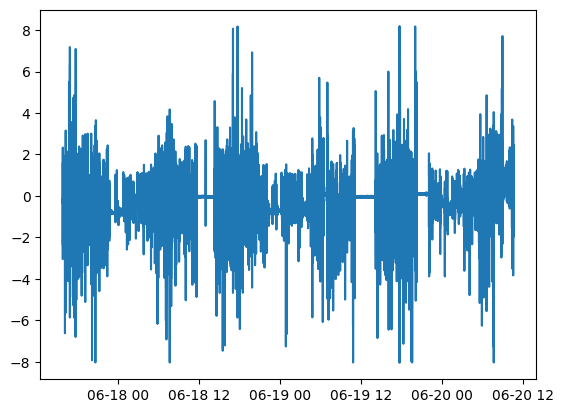
#Plot the light data:
plt.plot(watch_data.lux.time, watch_data.lux.measurements)
[<matplotlib.lines.Line2D at 0x2afc2ad90>]
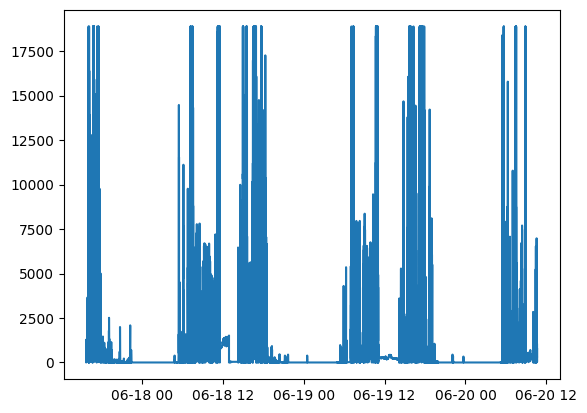
Example 3: Plot the epoch-level measurements¶
In this example we will expand on the skills learned in Example 2: we will load the sensor data, calibrate, and then calculate the ENMO and angle-z data in 5s windows (epoch-level data).
from wristpy.core import computations
from wristpy.io.readers import readers
from wristpy.processing import calibration, metrics
watch_data = readers.read_watch_data(input_directory / "three_nights.bin")
#Calibration phase
calibrator_object = calibration.ConstrainedMinimizationCalibration()
calibrated_data = calibrator_object.run_calibration(watch_data.acceleration)
#Compute the desired metrics
enmo = metrics.euclidean_norm_minus_one(calibrated_data)
anglez = metrics.angle_relative_to_horizontal(calibrated_data)
#Obtain the epoch-level data, default is 5s windows
enmo_epoch1 = computations.moving_mean(enmo)
anglez_epoch1 = computations.moving_mean(anglez)
We can then visualize the epoch1 measurements as:
fig, ax1 = plt.subplots()
ax1.plot(enmo_epoch1.time, enmo_epoch1.measurements, color='blue')
ax1.set_ylabel('ENMO', color='blue')
ax2 = ax1.twinx()
ax2.plot(anglez_epoch1.time, anglez_epoch1.measurements, color='red')
ax2.set_ylabel('Anglez', color='red')
plt.show()
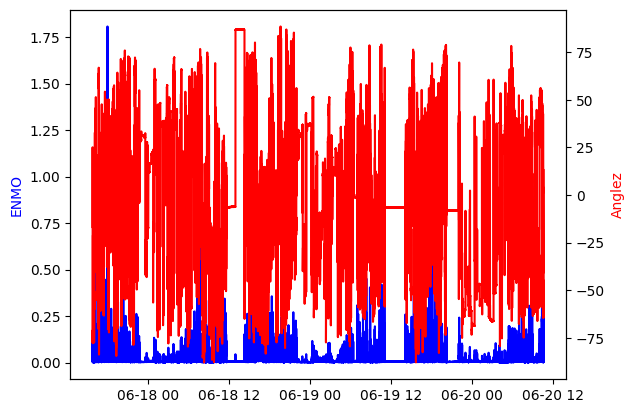
Example 4: Visualize the detected non-wear times¶
In this example we will build on Example 3 by also solving for the non-wear periods, as follows:
from wristpy.io.readers import readers
from wristpy.processing import calibration, metrics
watch_data = readers.read_watch_data(input_directory / "three_nights.bin")
calibrator_object = calibration.ConstrainedMinimizationCalibration()
calibrated_data = calibrator_object.run_calibration(watch_data.acceleration)
#Find non-wear periods, using the DETACH algorithm
non_wear_array = metrics.detect_nonwear(calibrated_data)
We can then visualize the non-wear periods, in comparison to movement (ENMO at the epoch-level):
from wristpy.core import computations
enmo = metrics.euclidean_norm_minus_one(calibrated_data)
enmo_epoch1 = computations.moving_mean(enmo)
plt.plot(enmo_epoch1.time, enmo_epoch1.measurements)
plt.plot(non_wear_array.time, non_wear_array.measurements)
plt.legend(['ENMO Epoch1', 'Non-wear'])
<matplotlib.legend.Legend at 0x2afbe5f50>
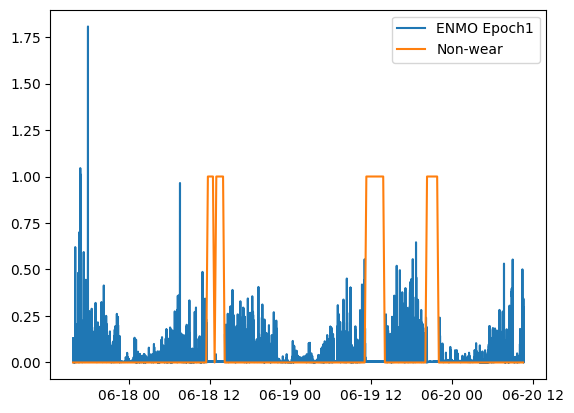
Example 5: Compute and plot the sleep windows¶
We can visualize the sleep periods in comparison to other metrics; in this example, we compare the sleep windows to the angle-z data and the non-wear periods. In the default pipeline any sleep periods that overlap with non-wear periods are filtered out. This plot shows the sleep periods visualized by a blue trace, non-wear periods are visualized with a green trace, and the angle-z data with the semi-transparent red trace. These are all accessible directly from the results object created with the custom pipeline:
import matplotlib.pyplot as plt
fig, ax1 = plt.subplots()
ax1.plot(results.sleep_status.time, results.sleep_status.measurements, color='blue', label='Sleep Periods')
plt.plot(results.nonwear_status.time, results.nonwear_status.measurements, color='green')
ax2 = ax1.twinx()
ax2.plot(results.anglez.time, results.anglez.measurements, color='red', alpha=0.5)
ax2.set_ylabel('Anglez Epoch1', color='red')
ax1.set_ylabel('Sleep Period/Non-wear')
ax1.set_ylim(0, 1.5)
plt.show()
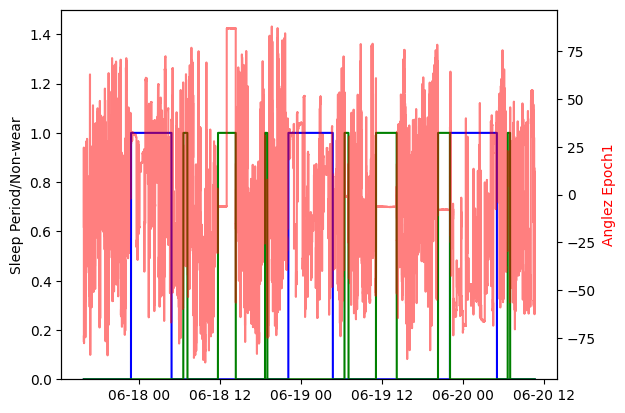
Docker Tutorial¶
Install Docker: Ensure you have Docker installed on your system. Get Docker
Pull the Docker image:
docker pull cmidair/wristpy:main
Run the Docker image with your data:
docker run -it --rm \ -v "/local/path/to/data:/data" \ -v "/local/path/to/output:/output" \ cmidair/wristpy:main
Replace
/local/path/to/datawith the path to your input data directory and/local/path/to/outputwith where you want results saved.To run a single file, we simply need to modify the mounting structure for the docker call slightly:
docker run -it --rm \ -v "/local/path/to/data/file.bin:/data/file.bin" \ -v "/local/path/to/output:/output" \ cmidair/wristpy:main
Customizing the Pipeline:
The Docker image supports multiple input variables to customize processing. You can set these by simply chaining these inputs as you would for the CLI input:
docker run -it --rm \
-v "/local/path/to/data/file.bin:/data/file.bin" \
-v "/local/path/to/output:/output" \
cmidair/wristpy:main /data --output /output --epoch-length 5 --nonwear-algorithm ggir --nonwear-algorithm detach --thresholds 0.1 0.2 0.4
Physical Activity Metrics Explained¶
ENMO— Euclidean Norm Minus One¶
ENMO quantifies movement intensity from calibrated 3-axis acceleration by taking the vector magnitude and subtracting 1 g (gravity). Values below zero are set to 0 (they mostly reflect noise or tiny calibration errors).
References:
van Hees, V. T., Gorzelniak, L., Dean León, E. C., Eder, M., Pias, M., Taherian, S., Ekelund, U., Renström, F., Franks, P. W., Horsch, A., & Brage, S. (2013). Separating movement and gravity components in an acceleration signal and implications for the assessment of human daily physical activity. PLoS ONE, 8(4), e61691. https://doi.org/10.1371/journal.pone.0061691
Hildebrand, M., van Hees, V. T., Hansen, B. H., & Ekelund, U. (2014). Age group comparability of raw accelerometer output from wrist- and hip-worn monitors. Medicine & Science in Sports & Exercise, 46(9), 1816–1824. https://doi.org/10.1249/MSS.0000000000000289
MAD — Mean Amplitude Deviation¶
MAD summarizes how much the acceleration magnitude fluctuates within an epoch. Specifically it’s the mean of the absolute deviations from the epoch’s mean acceleration magnitude. It correlates well with energy expenditure and is orientation-independent.
Reference:
Vähä-Ypyä, H., Vasankari, T., Husu, P., Suni, J., & Sievänen, H. (2015). A universal, accurate intensity-based classification of different physical activities using raw data of accelerometer. Clinical Physiology and Functional Imaging, 35(1), 64–70. https://doi.org/10.1111/cpf.12127
MIMS — Monitor-Independent Summary Units¶
MIMS is a standardized, device-agnostic summary unit. The pipeline interpolates to a fixed frequency (100 Hz), extrapolates values outside device range, band-pass filters, integrates area-under-the-curve per axis over each epoch, then combines axes (sum or vector magnitude) with small-value truncation. It’s designed to be comparable across devices and studies. This metric is computationally intensive and will run significantly slower than the other algorithms.
Reference:
John, D., Tang, Q., Albinali, F., & Intille, S. (2019). An open-source monitor-independent movement summary for accelerometer data processing. Journal for the Measurement of Physical Behaviour, 2(4), 268–281. https://doi.org/10.1123/jmpb.2019-0011
ActiGraph Activity Counts (ag_counts)¶
This reproduces the open ActiGraph counts method: resample to 30 Hz, apply the published IIR band-pass filter, scale to device units, threshold, downsample to 10 Hz, and sum within each epoch. The three axes are finally combined to yield epoch-level “counts.”
Reference:
Neishabouri, A., Wilson, K. E., Williams, D. K., Keadle, S. K., Sampson, J., John, D., & Staudenmayer, J. (2022). Quantification of acceleration as activity counts in ActiGraph wearable. Scientific Reports, 12(1), 11169. https://doi.org/10.1038/s41598-022-16003-x
A Special Note on Idle Sleep Mode.¶
The idle_sleep_mode for Actigraph watches will lead to uneven sampling rates during periods of no motion (read about this here). Consequently, this causes issues when implementing wristpy’s non-wear and sleep detection. As of this moment, we fill in the missing acceleration data with the assumption that the watch is perfectly idle in the face-up position (Acceleration vector = [0, 0, -1]). The data is filled in at the same sampling rate as the raw acceleration data. In the special circumstance when acceleration samples are not evenly spaced, the data is resampled to the highest effective sampling rate to ensure linearly sampled data.
References¶
[1] Vähä-Ypyä H, Vasankari T, Husu P, Suni J, Sievänen H. A universal, accurate intensity-based classification of different physical activities using raw data of accelerometer. Clin Physiol Funct Imaging. 2015;35(1):64-70. doi: https://doi.org/10.1111/cpf.12127. PMID: 24393233.
[2] Neishabouri A, Wilson KE, Williams DK, et al. Quantification of acceleration as activity counts in ActiGraph wearable. Sci Rep. 2022;12(1). doi: https://doi.org/10.1038/s41598-022-16003-x.
[3] John D, Tang Q, Albinali F, Intille S. An Open-Source Monitor-Independent Movement Summary for Accelerometer Data Processing. Journal for the Measurement of Physical Behaviour. 2019;2(4):268–281.
[4] Zhou S, Hill RA, Morgan K, et al. Classification of accelerometer wear and non-wear events in seconds for monitoring free-living physical activity. BMJ Open. 2015;5:e007447. doi: https://doi.org/10.1136/bmjopen-2014-007447.
[5] Vert A, et al. Detecting accelerometer non-wear periods using change in acceleration combined with rate-of-change in temperature. BMC Med Res Methodol. 2022;22(1):147. doi: https://doi.org/10.1186/s12874-022-01633-6.
[6] van Hees VT, Sabia S, Jones SE, et al. Estimating sleep parameters using an accelerometer without sleep diary. Sci Rep. 2018;8:12975. doi: https://doi.org/10.1038/s41598-018-31266-z.
[7] van Hees VT, et al. A Novel, Open Access Method to Assess Sleep Duration Using a Wrist-Worn Accelerometer. PLoS One. 2015;10:e0142533. doi: https://doi.org/10.1371/journal.pone.0142533.
[8] Hildebrand M, et al. Age group comparability of raw accelerometer output from wrist- and hip-worn monitors. Med Sci Sports Exerc. 2014;46(9):1816–1824. doi: https://doi.org/10.1249/mss.0000000000000289.
[9] Treuth MS, Schmitz K, Catellier DJ, et al. Defining accelerometer thresholds for activity intensities in adolescent girls. Med Sci Sports Exerc. 2004;36(7):1259–1266. PMID: 15235335; PMCID: PMC2423321.
[10] Aittasalo M, Vähä-Ypyä H, Vasankari T, et al. Mean amplitude deviation calculated from raw acceleration data: a novel method for classifying the intensity of adolescents’ physical activity irrespective of accelerometer brand. BMC Sports Sci Med Rehabil. 2015;7:18. doi: https://doi.org/10.1186/s13102-015-0010-0.